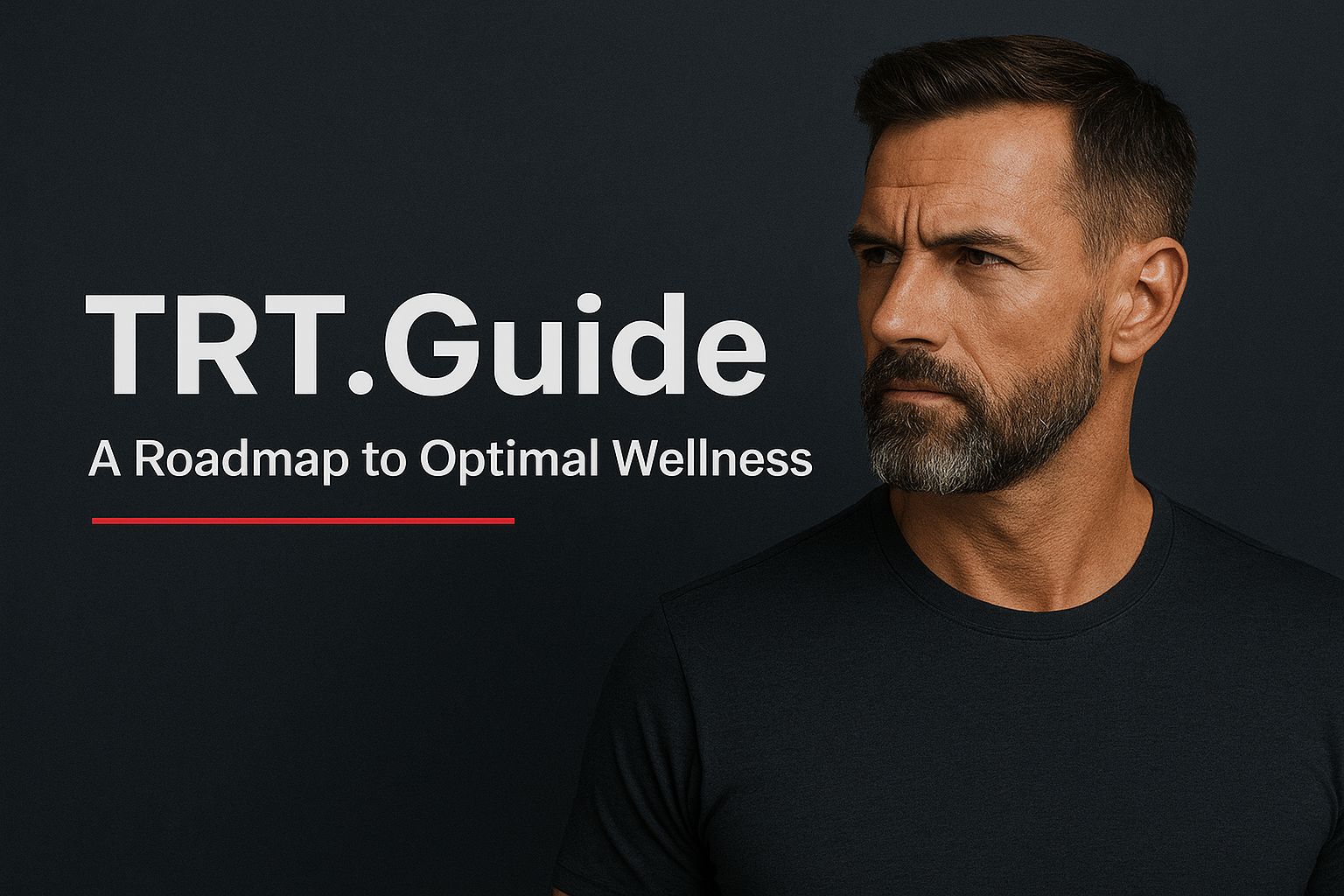If you’re feeling more fatigued than usual or struggling with mood swings, you might be wondering about testosterone therapy in Austin. Many men experience a natural decline in testosterone levels as they age, leading to a range of physical and emotional challenges. Fortunately, testosterone therapy offers a potential solution to help restore balance and improve your quality of life.
In Austin, a growing number of clinics specialize in personalized testosterone treatment plans tailored to your specific needs. Whether you’re seeking to boost your energy, enhance your libido, or improve your overall well-being, understanding the benefits and options available can empower you to make informed decisions. Get ready to explore how testosterone therapy can help you regain vitality and confidence in your daily life.
Understanding Testosterone Therapy
Testosterone therapy focuses on restoring testosterone levels in men who experience deficiencies. This treatment aims to alleviate symptoms associated with low testosterone, including fatigue and mood swings.
What Is Testosterone Therapy?
Testosterone therapy involves administering testosterone to increase low levels in the body. Various forms are available, including injections, gels, and patches. These methods deliver testosterone into your system to boost its presence, improving physical and mental well-being.
Doctors typically prescribe therapy after conducting blood tests to assess hormone levels. The aim is to restore testosterone to normal ranges, facilitating optimal body function. Regular monitoring ensures therapy remains effective and safe for your health.
Benefits of Testosterone Therapy
Testosterone therapy offers several benefits that enhance quality of life for men with low testosterone levels:
- Improved Energy Levels: Many men report increased stamina and reduced fatigue following treatment.
- Enhanced Mood: Therapy helps alleviate symptoms of anxiety and depression associated with low testosterone.
- Increased Libido: Many individuals experience heightened sexual desire and improved sexual function.
- Better Muscle Mass: Treatment often leads to increased muscle strength and mass, supporting fitness goals.
- Improved Bone Density: Adequate testosterone boosts bone strength, reducing the risk of fractures.
Men seeking to regain vitality and improve overall health may find these benefits significant.
Who Is a Candidate for Testosterone Therapy?
Candidates for testosterone therapy typically include men experiencing symptoms related to low testosterone levels. Common signs include:
- Fatigue: Persistent tiredness despite adequate sleep.
- Reduced Libido: Noticeable decrease in sexual interest.
- Mood Changes: Increased feelings of sadness or irritability.
- Reduced Muscle Strength: Difficulty maintaining muscle mass with regular exercise.
- Cognitive Decline: Trouble focusing or remembering details.
Medical professionals assess your symptoms alongside blood test results to determine suitability for therapy. Age and overall health also play crucial roles in this decision.
Types of Testosterone Therapy
Testosterone therapy provides different options for those addressing low testosterone levels. Understanding these methods helps you choose the best fit for your needs.
Injections
Injections represent a common method of testosterone therapy. These involve administering testosterone directly into the muscle, typically every one to four weeks. Health care providers determine the exact frequency based on individual hormone levels and symptoms.
Injections allow for precise dosage control, ensuring adequate testosterone levels in the bloodstream. Various formulations exist, including testosterone cypionate and testosterone enanthate. Each has its specific absorption rates, affecting how quickly testosterone enters the body and how long it lasts. Some men find injections beneficial due to their effectiveness and fewer applications compared to daily topical methods.
Before starting the injection process, your doctor conducts blood tests to determine baseline testosterone levels. Regular follow-ups monitor levels and adjust dosages as necessary. Benefits of injections include sustained hormone levels, improved mood, and increased muscle mass. Side effects may include discomfort at the injection site, changes in mood, or fluctuations in energy levels.
Topical Gels
Topical gels offer another practical option for testosterone therapy. These gels are applied to the skin, often on the shoulders or upper arms, once daily. The absorption through the skin provides a steady release of testosterone throughout the day.
One significant advantage of gels is convenience. No need for needles simplifies the process for many users. Additionally, testosterone levels remain more stable than with injections. Manufacturers provide various gel products, with differing concentrations to suit individual needs.
Before applying the gel, ensure clean, dry skin for optimal absorption. After application, wash your hands thoroughly to avoid transmission to others. Potential side effects can include skin irritation, mood changes, or unwanted hair growth. Regular blood tests help monitor testosterone levels and assess the effectiveness of this method.
Pellets
Pellets present a less common but effective method of testosterone therapy. These small, solid implants consist of testosterone and get inserted under the skin, usually in the hip area. Each pellet releases testosterone gradually over time, requiring replacement only every three to six months.
Pellets provide consistent hormone levels, avoiding the peaks and valleys associated with other methods. The insertion process occurs during an outpatient procedure, typically taking less than 30 minutes.
After insertion, you might experience some swelling or bruising at the site, but these usually resolve quickly. Regular follow-ups ensure the therapy remains effective. As the method suits many men, pellets help increase energy levels, enhance moods, and improve overall well-being.
Other Methods
Other methods include nasal sprays, buccal tablets, and patches. These alternatives cater to different preferences and lifestyles.
Nasal sprays involve applying testosterone directly into the nostrils several times a day, allowing efficient absorption. Buccal tablets place testosterone against the gum, slowly dissolving and entering the bloodstream, typically requiring twice-daily use.
Transdermal patches offer a similar application to topical gels, providing a steady dose of testosterone through the skin. Each method presents its own set of benefits and potential side effects, including skin reactions and fluctuations in hormone levels.
Ultimately, discussing all options with your health care provider leads to a better understanding of which testosterone therapy method is suitable for you. Regular monitoring and adjustments ensure optimal results throughout your therapy experience.
Preparing for Testosterone Therapy
Preparation for testosterone therapy involves several important steps. These steps ensure that you receive safe and effective treatment.
Consultation with a Doctor
Consult with a doctor specializing in hormone therapy. This visit allows you to discuss your symptoms and medical history. Your doctor will assess your overall health and hormone-related issues. Be open about all experiences related to fatigue, mood swings, and libido. These conversations provide valuable insight for your doctor. Ask questions about the therapy process, including treatment options and expected outcomes.
Doctors often recommend making lifestyle changes before starting therapy. Changes may include improving your diet, increasing exercise, and managing stress. These adjustments can enhance the therapy’s effectiveness. Your doctor may also work with other specialists to create a comprehensive plan tailored to your health needs. Establishing this collaborative relationship fosters better results.
Required Tests and Evaluations
Before starting testosterone therapy, expect to undergo several tests and evaluations. Initial blood tests measure your testosterone levels. These tests determine if hormone levels fall within normal ranges or indicate deficiencies. In addition to testosterone tests, doctors often check other hormone levels that may affect treatment outcomes.
Examples of these tests include checking levels of luteinizing hormone and follicle-stimulating hormone. These evaluations help identify the cause of low testosterone levels. Your doctor may also conduct a comprehensive health assessment, which includes evaluating your heart health and other medical conditions.
Anticipate follow-up evaluations after starting therapy. These tests allow your doctor to monitor testosterone levels and adjust treatment as necessary. Regular assessments ensure optimal results from therapy, keeping your health and safety a top priority.
Discussing Potential Risks
Discuss potential risks associated with testosterone therapy during your consultation. Acknowledge that while therapy offers benefits, it may also result in side effects. Common side effects include skin reactions from topical treatments, increased red blood cell count, or changes in mood.
Your doctor should explain these risks thoroughly. Specific concerns may depend on your health history and individual risk factors. For example, testosterone therapy can influence prostate health. Those with a history of prostate issues should explore these concerns with their doctor.
Stay informed about the signs of complications such as increased blood clots or sleep apnea symptoms. Understanding these risks allows you to make informed decisions about your therapy. Establish regular communication with your healthcare provider to address any concerns during treatment. This proactive approach ensures a safe process as you undergo therapy.
The Process of Starting Testosterone Therapy
Starting testosterone therapy involves several steps to ensure a suitable and safe treatment approach. This section outlines the essential procedures to initiate therapy effectively.
Administering Injections
Injections represent a common and effective method for delivering testosterone. Typically administered intramuscularly, injections allow for precise control over dosages. Medical professionals often recommend this method due to its efficient absorption into the bloodstream.
- Consult the Healthcare Provider: Schedule an appointment to discuss symptoms and clarify any questions about the injection process. A healthcare provider assesses your overall health and evaluates factors affecting testosterone levels.
- Receive Initial Blood Tests: Expect to undergo blood tests to determine baseline testosterone levels. These tests guide dosage decisions and establish a starting point for future comparisons.
- Understand Injection Frequency: Injections usually occur every one to two weeks, depending on individual needs and prescribed dosage. Understanding the frequency of injections contributes to consistent hormone levels.
- Learn Injection Techniques: Healthcare providers explain how to administer injections safely at home. Familiarize yourself with proper techniques, such as selecting the injection site and preparing the testosterone vial.
- Monitor Side Effects: After administration, keep track of any side effects you experience. Common side effects include injection site pain, changes in mood, or fatigue. Contact your healthcare provider immediately for any significant concerns.
- Schedule Follow-Up Appointments: Regular follow-up visits are crucial to monitor hormone levels and adjust dosages if necessary. These appointments ensure the therapy remains effective and safe over time.
Applying Topical Gels
Topical gels offer a convenient way to administer testosterone. Understanding how to apply these gels ensures effective treatment and optimal hormone absorption.
Application Guidelines
- Choose the right location: Select clean and dry areas of the skin for application. Common sites include the shoulders, upper arms, or abdomen. Avoid areas like the genitals or any areas with broken skin.
- Clean the skin: Wash the chosen area with soap and water, then pat it dry. Fresh, clean skin increases absorption and minimizes irritation.
- Apply the gel: Squeeze the recommended amount of gel onto your fingertips. Gently rub the gel into the skin until it’s fully absorbed. Follow your healthcare provider’s dosage instructions carefully to ensure proper administration.
- Wash hands immediately: After applying the gel, wash your hands thoroughly with soap and water. This step prevents unintentional transfer of testosterone to others.
- Allow drying time: Wait at least 5 to 10 minutes before putting on clothing. This ensures the gel fully dries and reduces the risk of staining clothes or transferring the gel.
- Avoid swimming or bathing: Steer clear of water activities for at least 2 hours after application. This practice prevents loss of testosterone and ensures maximum effectiveness.
- Monitor for side effects: Regularly check for any skin irritation or unusual symptoms. If experiencing discomfort, contact your healthcare provider immediately to address concerns.
- Keep the product away from others: Limit skin contact with others, particularly women and children, until the application site is fully dry. Testosterone can transfer through skin contact.
Applying topical gels correctly maximizes the benefits of testosterone therapy and helps ensure patients experience the desired improvement in symptoms. Regular communication with your healthcare provider remains essential for monitoring treatment efficacy.
Inserting Pellets
Inserting testosterone pellets involves a straightforward and efficient procedure. This method delivers a consistent release of testosterone over several months.
Procedure Overview
- Consultation: Schedule an appointment with a healthcare provider. Discuss your symptoms and medical history to ensure suitability for pellet insertion.
- Preparation: Arrive for your appointment with clean skin. The healthcare professional will assess your general health and hormone levels to confirm the need for pellets.
- Anesthesia: The provider will apply a local anesthetic to the insertion site. This minimizes discomfort during the procedure.
- Insertion: A small incision is made in the skin, typically in the hip or buttock area. The healthcare provider inserts tiny pellets, about the size of a grain of rice, directly under the skin. Each pellet contains testosterone.
- Closure: After inserting the pellets, the healthcare provider will close the incision with a small bandage or adhesive strip.
- Aftercare: Follow instructions for post-procedure care. Avoid strenuous activities for a few days to allow for proper healing.
This method allows for steady testosterone levels without the need for daily application or weekly injections. Regular follow-ups will help monitor hormone levels and assess the effectiveness of the therapy.
Benefits of Pellet Therapy
- Consistent Release: Testosterone pellets release hormones steadily, maintaining balanced levels in the body.
- Long-lasting: Each pellet lasts between three to six months, reducing the frequency of treatments.
- Discreet: The small size of the pellets and the hidden location provide a discreet treatment option.
- Minimal Discomfort: Most patients report minimal pain associated with the insertion process due to the local anesthesia used.
- Convenience: Pellet therapy eliminates daily applications or frequent injections, simplifying hormone management.
Choosing pellet therapy can be a significant step in regaining energy, mood, and overall well-being. Ensure you follow up with your healthcare provider to monitor your progress and make any necessary adjustments.
Monitoring and Adjusting Testosterone Therapy
Monitoring and adjusting testosterone therapy ensures that patients receive optimal treatment. Regular assessments help maintain the effectiveness and safety of the therapy.
Regular Follow-Up Appointments
Schedule regular follow-up appointments with your healthcare provider. These check-ups allow for consistent evaluation of your hormone levels and overall health. Typically, appointments occur every three to six months after initiating therapy. During these visits, medical professionals conduct blood tests to measure testosterone levels and monitor for potential side effects.
Communicate openly during appointments about any physical or emotional changes experienced since beginning therapy. Notify your doctor about variations in energy levels, mood, and physical performance. Discussing symptoms helps the provider make informed decisions regarding your treatment plan.
The frequency of follow-ups may increase based on individual health needs or specific outcomes from blood tests. Adjustments in therapy could occur if testosterone levels fall outside the desired range or if side effects become prevalent. Prioritize these appointments to maintain a successful and safe treatment experience.
Evaluating Treatment Effectiveness
Evaluate the effectiveness of your testosterone therapy through multiple factors. Begin with regular blood tests that assess your testosterone levels, comparing them to the normal range specified by medical guidelines. Positive results typically manifest as reduced symptoms related to low testosterone, such as enhanced energy, improved mood, and increased libido.
Another important aspect involves monitoring your physical performance. Track changes in muscle mass, strength, and endurance. Improvement in these areas indicates that therapy effectively raises testosterone levels.
Regularly assess emotional and psychological well-being as well. If therapy significantly reduces mood swings or feelings of depression, it indicates a successful adjustment of hormone levels. Document any enhancements in quality of life that you experience, as this information contributes to discussions with your healthcare provider.
Discuss treatment effectiveness during follow-up appointments to facilitate any necessary adjustments. Understanding progress outlines the path ahead and informs your doctor of any changes in your experience that require attention.
Adjusting Dosage and Formulation
Adjusting dosage and formulation remains vital throughout testosterone therapy. If blood test results indicate that hormone levels remain below or above optimal levels, your healthcare provider may modify your dosage. This ensures a balanced approach tailored to your physiological needs.
Your doctor may suggest changing the formulation as well. If experiencing adverse side effects with a method like injections, alternatives such as gels or pellets might provide a better fit. Each formulation offers unique benefits and potential drawbacks; discussing these options aids in determining the best choice for your situation.
Monitor your body’s response closely after any changes to dosage or formulation. Note any effects, positive or negative, and communicate these during follow-up appointments. Adjustment may require experimentation to find the ideal balance that accommodates your hormone levels and overall well-being.
Regular monitoring and adjustments form the cornerstone of effective testosterone therapy. Prioritize communication with your healthcare provider, and stay engaged in the therapeutic process for the best outcomes.
Potential Side Effects and Risks
Testosterone therapy presents several potential side effects and risks that individuals should consider before starting treatment. Understanding these aspects ensures informed decisions and improved safety during therapy.
Common Side Effects
Common side effects of testosterone therapy include:
- Acne or oily skin: Skin changes often occur during treatment as hormone levels adjust. Regular skincare routines may help manage these effects.
- Hair loss or growth: Some individuals experience increased body hair or hair loss on the scalp. Monitoring hair patterns can provide necessary insight into any changes.
- Mood swings: Fluctuations in mood may happen, leading to irritability or anxiety. Regular check-ins with healthcare providers ensure emotional health is addressed.
- Sleep disturbances: Some individuals report issues such as sleep apnea or insomnia. Tracking sleep quality helps manage these complications effectively.
- Fatigue: While testosterone therapy aims to boost energy, some individuals may experience fatigue. Consistent evaluations of energy levels help address this side effect.
- Fluid retention: Swelling in the feet or ankles can occur. Monitoring weight and swelling informs healthcare providers about possible adjustments.
- Increased red blood cell count: Higher levels of red blood cells can lead to health concerns. Regular blood tests are essential for monitoring this parameter.
- Increased breast tissue: Some men may develop breast enlargement or sensitivity. Open discussions with healthcare providers can promote the best management approach.
These side effects often subside as your body adjusts to therapy. Close monitoring and communication with your healthcare provider is crucial for detecting any enduring or worsening effects.
Serious Risks to Consider
Serious risks associated with testosterone therapy warrant attention:
- Cardiovascular issues: Potential heart problems, including heart attacks and strokes, have been linked to testosterone therapy. Evaluating heart health before initiating therapy is essential.
- Prostate health concerns: Testosterone can stimulate prostate tissue growth. Screening for prostate cancer and monitoring PSA levels ensures proactive management.
- Liver damage: Oral testosterone supplements may pose risks to liver health. Regular liver function tests help assess any concerning changes.
- Blood clots: An increase in red blood cell count raises the risk of blood clots. Awareness of symptoms like leg swelling or pain prompts timely evaluations.
- Sleep apnea: Individuals with a history of sleep apnea may experience worsened symptoms. Monitoring sleep patterns allows for timely adjustments.
- Mood disorders: Some may experience worsening anxiety or depression. Mental health assessments provide a clearer picture of overall well-being.
- Gynecomastia: Growth of breast tissue can occur in men undergoing therapy. Communication with healthcare providers allows for effective management options.
- Diabetes risk: Testosterone therapy could influence insulin sensitivity, potentially increasing diabetes risk. Regular blood sugar monitoring is advisable.
Understanding these risks emphasizes the requirement for consistent healthcare supervision while undergoing testosterone therapy. Regular assessments can help fulfill safety and health objectives.
When to Contact Your Doctor
You must contact your healthcare provider in the following situations:
- Severe mood changes: Notify your doctor about extreme mood swings, irritability, or depressive symptoms. Immediate adjustments can safeguard emotional well-being.
- Signs of cardiovascular issues: Seek guidance if experiencing chest pain, shortness of breath, or sudden weakness. Early intervention is key to managing serious heart conditions.
- Unusual swelling: Report any unexplained swelling in the legs, ankles, or feet. This symptom can signal fluid retention or blood clots.
- Severe headaches: If you experience debilitating headaches or visual changes, contact your healthcare provider. These symptoms may indicate pressure changes.
- Sleep disturbances: Report significant issues with sleep quality, especially if sleep apnea symptoms worsen. Adjustments can improve your overall health.
- Unexpected weight gain: Notify your doctor if unexpected weight gain occurs rapidly. Weight changes can indicate fluid retention or other imbalances.
- Breast changes: If breast tenderness or enlargement occurs, consult your healthcare provider. Early management can help ease concerns.
- Symptoms of liver issues: Seek advice if experiencing yellowing of the skin, dark urine, or abdominal pain. Liver function monitoring ensures proactive care.
Maintaining open communication with your healthcare provider ensures safe and effective management of any side effects or concerns arising during testosterone therapy. Regular check-ins facilitate timely interventions when needed.
Tips for Success with Testosterone Therapy
Lifestyle Changes to Complement Treatment
Implementing specific lifestyle changes enhances the effectiveness of testosterone therapy. Focus on maintaining a balanced diet rich in whole foods, including lean proteins, fruits, vegetables, and healthy fats. Specific nutrients like zinc and vitamin D support testosterone levels. Regular physical activity plays a significant role; aim for at least 150 minutes of moderate-intensity exercise weekly. Strength training two to three times a week helps build muscle and improve mood.
Incorporate stress management techniques into your routine. Practices such as yoga, meditation, or mindfulness reduce stress hormones that can negatively impact testosterone levels. Prioritize sufficient sleep as well. Aim for 7 to 9 hours of quality sleep each night. Poor sleep adversely affects hormone regulation, so establishing a regular sleep schedule is vital.
Limit alcohol consumption and avoid tobacco products. Both behaviors can lower testosterone levels and hinder overall health. Stay hydrated, as proper hydration impacts energy levels and general well-being. Establishing these healthy habits can maximize the results of your therapy, contributing to improved energy and mood.
Importance of Adherence to Therapy
Adhering to testosterone therapy ensures optimal results and maintains balanced hormone levels. Stick to your prescribed treatment regimen, whether it involves injections, gels, or pellets. Missing doses can lead to fluctuations in testosterone levels, affecting your mood, energy, and overall health.
Regularly attend follow-up appointments to monitor progress. Healthcare providers assess hormone levels and make necessary adjustments to your treatment plan. Open communication during these appointments allows for better understanding of side effects and potential concerns. Discuss any changes in symptoms so your provider can modify your therapy if needed.
Educate yourself about testosterone therapy, its benefits, and potential side effects. Being informed empowers you to take an active role in your health. Ask questions and clarify any doubts with your healthcare provider. Understanding the importance of adherence creates accountability and supports positive outcomes in your treatment.
Support Systems and Resources
Utilize support systems to enhance your experience with testosterone therapy. Engage with healthcare professionals who specialize in hormone therapy. Their expertise can guide you through the treatment process and address any challenges that arise.
Connect with peers who are undergoing similar therapy. Support groups provide a platform to share experiences, challenges, and tips. Online forums and local meet-ups offer a space for discussion and camaraderie. Listening to others can provide valuable insights and encouragement.
Resources such as educational websites, books, and articles can expand your knowledge about testosterone therapy. Seek materials focused on the latest research and recommendations. Staying informed empowers you to make decisions that align with your health goals.
Consider working with a nutritionist or fitness coach who understands the impact of testosterone therapy. Personalized guidance on diet and exercise improves compliance and therapy effectiveness. Support from professionals and peers contributes to long-term success in managing your health.
Troubleshooting Common Issues
Issues may arise during testosterone therapy. Addressing these concerns promptly leads to safer and more effective treatment.
Difficulty with Administration
Administration methods for testosterone therapy can sometimes pose challenges. For injections, improper technique may cause discomfort or ineffective delivery. Ensure you follow your healthcare provider’s instructions carefully. Using a precise method helps minimize pain and ensures proper absorption. Practicing with a healthcare professional can enhance your skills and confidence.
For topical gels, applying too little or incorrectly can compromise effectiveness. Use a sufficient amount and apply it to clean, dry skin as instructed, avoiding areas with broken skin or excessive hair. Allow the gel to dry before dressing to prevent transfer. If you experience skin irritation, communicate this to your doctor, as adjustments or alternative methods may be necessary.
Pellet insertion also presents unique challenges. If pellets feel uncomfortable or noticeable beneath the skin, inform your doctor. Follow-up visits are essential to ensure proper placement and functioning of the pellets. For alternative methods such as patches or sprays, ensure you understand how to use them effectively for optimal results.
Increased Side Effects
Side effects can occur during testosterone therapy. While some individuals may experience mild side effects that diminish with time, others face more significant issues. Keep an open line of communication with your healthcare provider regarding side effects.
Common side effects include mood swings, acne, and changes in sleep patterns. Document any side effects you encounter and share this during follow-up appointments. Adjustments, such as altering dosages or switching methods, may alleviate these issues.
If you experience severe side effects—like chest pain, difficulty breathing, or mood disturbances—seek immediate medical attention. Your doctor evaluates the need for immediate adjustments or additional testing to ensure your safety. Being proactive regarding side effects contributes to a more effective and comfortable therapy experience.
Lack of Improvement in Symptoms
If symptoms persist despite testosterone therapy, it raises concerns. Regular monitoring of hormone levels and symptoms is crucial to assess therapy effectiveness. Communicate any ongoing fatigue, mood changes, or reduced libido to your healthcare provider.
Several factors may contribute to a lack of improvement. Dosage adjustments might be necessary if your body does not respond adequately. Hormone levels fluctuate between individuals, requiring tailored approaches. Engage your doctor to review test results to address possible underlying issues.
Additionally, lifestyle factors can influence overall well-being. Maintain a balanced diet, regular exercise routine, and manage stress effectively. These combined efforts can significantly enhance therapy outcomes. Identifying barriers to progress is essential for improving your overall experience with testosterone therapy. Collaboration with healthcare providers ensures the best path forward.
Conclusion
Exploring testosterone therapy in Austin could be your key to revitalizing your energy and improving your overall well-being. With a variety of treatment options tailored to your needs and preferences, you’re equipped to make informed decisions about your health.
Regular consultations with healthcare providers will help ensure that your therapy remains effective and safe. By addressing any concerns and monitoring your progress, you can maximize the benefits of testosterone therapy.
Don’t hesitate to take the first step towards regaining your vitality and confidence. Embrace the possibilities that come with appropriate treatment and lifestyle changes, and enjoy a more fulfilling life.
Frequently Asked Questions
What is testosterone therapy and who can benefit from it?
Testosterone therapy is a treatment designed to raise testosterone levels in men experiencing symptoms like fatigue, mood swings, and reduced libido. Candidates typically include men showing such symptoms and have low testosterone levels determined through blood tests.
What methods are available for testosterone therapy?
Testosterone therapy can be administered through various methods, including intramuscular injections, topical gels, skin patches, and pellets. Each method offers distinct benefits and should be discussed with a healthcare provider to find the most suitable option.
How is testosterone therapy monitored?
Monitoring testosterone therapy involves regular follow-up appointments, typically every three to six months. These visits include blood tests to evaluate hormone levels and assess treatment effectiveness, alongside discussions about any physical or emotional changes experienced.
What are the side effects of testosterone therapy?
Potential side effects of testosterone therapy can include injection site discomfort, mood changes, and potential prostate health concerns. It’s important to communicate any adverse effects to your healthcare provider for timely adjustments and safety.
How can I prepare for testosterone therapy?
Preparing for testosterone therapy includes a consultation with a healthcare provider to discuss symptoms and medical history. Patients should also consider making lifestyle changes, such as improving diet and increasing physical activity, to enhance the therapy’s effectiveness.






